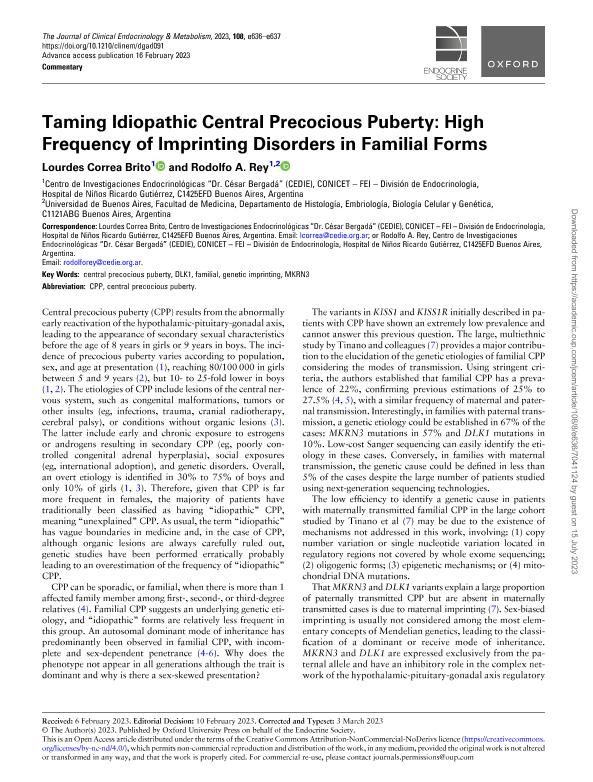Mostrar el registro sencillo del ítem
dc.contributor.author
Correa Brito, Lourdes Magdalena

dc.contributor.author
Rey, Rodolfo Alberto

dc.date.available
2024-02-29T13:19:22Z
dc.date.issued
2023-08
dc.identifier.citation
Correa Brito, Lourdes Magdalena; Rey, Rodolfo Alberto; Taming Idiopathic Central Precocious Puberty: High Frequency of Imprinting Disorders in Familial Forms; Endocrine Society; Journal of Clinical Endocrinology and Metabolism; 108; 8; 8-2023; e636-e637
dc.identifier.issn
0021-972X
dc.identifier.uri
http://hdl.handle.net/11336/228922
dc.description.abstract
Central precocious puberty (CPP) results from the abnormally early reactivation of the hypothalamic-pituitary-gonadal axis, leading to the appearance of secondary sexual characteristics before the age of 8 years in girls or 9 years in boys. The incidence of precocious puberty varies according to population, sex, and age at presentation (1), reaching 80/100 000 in girls between 5 and 9 years (2), but 10- to 25-fold lower in boys (1, 2). The etiologies of CPP include lesions of the central nervous system, such as congenital malformations, tumors or other insults (eg, infections, trauma, cranial radiotherapy, cerebral palsy), or conditions without organic lesions (3). The latter include early and chronic exposure to estrogens or androgens resulting in secondary CPP (eg, poorly controlled congenital adrenal hyperplasia), social exposures (eg, international adoption), and genetic disorders. Overall, an overt etiology is identified in 30% to 75% of boys and only 10% of girls (1, 3). Therefore, given that CPP is far more frequent in females, the majority of patients have traditionally been classified as having “idiopathic” CPP, meaning “unexplained” CPP. As usual, the term “idiopathic” has vague boundaries in medicine and, in the case of CPP, although organic lesions are always carefully ruled out, genetic studies have been performed erratically probably leading to an overestimation of the frequency of “idiopathic” CPP.
dc.format
application/pdf
dc.language.iso
eng
dc.publisher
Endocrine Society

dc.rights
info:eu-repo/semantics/openAccess
dc.rights.uri
https://creativecommons.org/licenses/by-nc-nd/2.5/ar/
dc.subject
CENTRAL PRECOCIOUS PUBERTY
dc.subject
DLK1
dc.subject
FAMILIAL
dc.subject
GENETIC IMPRINTING
dc.subject
MKRN3
dc.subject.classification
Endocrinología y Metabolismo

dc.subject.classification
Medicina Clínica

dc.subject.classification
CIENCIAS MÉDICAS Y DE LA SALUD

dc.title
Taming Idiopathic Central Precocious Puberty: High Frequency of Imprinting Disorders in Familial Forms
dc.type
info:eu-repo/semantics/article
dc.type
info:ar-repo/semantics/artículo
dc.type
info:eu-repo/semantics/publishedVersion
dc.date.updated
2024-02-28T10:17:05Z
dc.identifier.eissn
1945-7197
dc.journal.volume
108
dc.journal.number
8
dc.journal.pagination
e636-e637
dc.journal.pais
Estados Unidos

dc.description.fil
Fil: Correa Brito, Lourdes Magdalena. Consejo Nacional de Investigaciones Científicas y Técnicas. Oficina de Coordinación Administrativa Parque Centenario. Centro de Investigaciones Endocrinológicas "Dr. César Bergada". Gobierno de la Ciudad de Buenos Aires. Centro de Investigaciones Endocrinológicas "Dr. César Bergada". Fundación de Endocrinología Infantil. Centro de Investigaciones Endocrinológicas "Dr. César Bergada"; Argentina
dc.description.fil
Fil: Rey, Rodolfo Alberto. Consejo Nacional de Investigaciones Científicas y Técnicas. Oficina de Coordinación Administrativa Parque Centenario. Centro de Investigaciones Endocrinológicas "Dr. César Bergada". Gobierno de la Ciudad de Buenos Aires. Centro de Investigaciones Endocrinológicas "Dr. César Bergada". Fundación de Endocrinología Infantil. Centro de Investigaciones Endocrinológicas "Dr. César Bergada"; Argentina
dc.journal.title
Journal of Clinical Endocrinology and Metabolism

dc.relation.alternativeid
info:eu-repo/semantics/altIdentifier/url/https://academic.oup.com/jcem/article/108/8/e636/7041124
dc.relation.alternativeid
info:eu-repo/semantics/altIdentifier/doi/http://dx.doi.org/10.1210/clinem/dgad091
Archivos asociados
